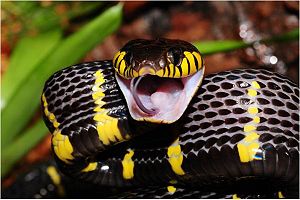Sandbox Reserved 932
From Proteopedia
| Line 43: | Line 43: | ||
[[Image:Bungarotoxin interaction with nACHr figure text.png|300px|right|thumb| Figure 3. Suggested interaction of '''α-bungarotoxin''' in binding pocket of nAChR (simplified figure) [PDB=4HQP]]] | [[Image:Bungarotoxin interaction with nACHr figure text.png|300px|right|thumb| Figure 3. Suggested interaction of '''α-bungarotoxin''' in binding pocket of nAChR (simplified figure) [PDB=4HQP]]] | ||
| - | Most of the 3FTX family proteins possess a highly conserved arginine in the tip of their binding loop responsible for interaction with nAChRs. This interaction was determined by resolving a structure of α7 nAChR chimera in a complex with α-bungarotoxin (fig. 3) <ref>Huang S. ''et al.'', [http://www.ncbi.nlm.nih.gov/pmc/articles/PMC3920732/ "Complex between α-bungarotoxin and an α7 nicotinic receptor ligand-binding domain chimaera"], ''Biochem J. 454(2): 303–310.'', Septemper 1, 2013. Retrieved May 19, 2014.</ref>. In denmotoxin, this loop contains several changes in its sequence; arginine has replaced by aspartic acid (ASP41) and two additional glutamates (GLU42 & GLU45) generate untypical | + | Most of the 3FTX family proteins possess a highly conserved arginine in the tip of their binding loop responsible for interaction with nAChRs. This interaction was determined by resolving a structure of α7 nAChR chimera in a complex with α-bungarotoxin (fig. 3) <ref>Huang S. ''et al.'', [http://www.ncbi.nlm.nih.gov/pmc/articles/PMC3920732/ "Complex between α-bungarotoxin and an α7 nicotinic receptor ligand-binding domain chimaera"], ''Biochem J. 454(2): 303–310.'', Septemper 1, 2013. Retrieved May 19, 2014.</ref>. In denmotoxin, this loop contains <scene name='57/579702/Active_site/2'>several changes</scene> in its sequence; arginine has replaced by aspartic acid (ASP41) and two additional glutamates (GLU42 & GLU45) generate untypical negative charge into the loop. <ref name=Pawlak/> |
Biochemistry of denmotoxin is unique for its taxon specificity to bird nicotinic acetylcholine receptors (nAChR). Binding of denmotoxin to chick muscle AChR (α1βγδ) is a highly irreversible whereas interaction with identical subunit assembly in mouse AChR is reversible. The reversible binding allows the receptor to function properly, but in the case of irreversible binding nAChR is prevented of natural agonist activation. Previous studies <ref>Samson. A. O. & Levitt M., [http://pubs.acs.org/doi/abs/10.1021/bi702272j "Inhibition Mechanism of the Acetylcholine Receptor by α-Neurotoxins as Revealed by Normal-Mode Dynamics"], ''Biochemistry, 2008, 47 (13), pp 4065–4070'', March 8, 2008. Retrieved May 19, 2014.</ref> with 3FTXs have shown that the binding of toxin leads to “locking down” of the nACh receptor, preventing required conformational change for ion channel activation and induction of signal. <ref name=Pawlak/> | Biochemistry of denmotoxin is unique for its taxon specificity to bird nicotinic acetylcholine receptors (nAChR). Binding of denmotoxin to chick muscle AChR (α1βγδ) is a highly irreversible whereas interaction with identical subunit assembly in mouse AChR is reversible. The reversible binding allows the receptor to function properly, but in the case of irreversible binding nAChR is prevented of natural agonist activation. Previous studies <ref>Samson. A. O. & Levitt M., [http://pubs.acs.org/doi/abs/10.1021/bi702272j "Inhibition Mechanism of the Acetylcholine Receptor by α-Neurotoxins as Revealed by Normal-Mode Dynamics"], ''Biochemistry, 2008, 47 (13), pp 4065–4070'', March 8, 2008. Retrieved May 19, 2014.</ref> with 3FTXs have shown that the binding of toxin leads to “locking down” of the nACh receptor, preventing required conformational change for ion channel activation and induction of signal. <ref name=Pawlak/> | ||
Revision as of 12:21, 18 May 2014
| This Sandbox is Reserved from 01/04/2014, through 30/06/2014 for use in the course "510042. Protein structure, function and folding" taught by Prof Adrian Goldman, Tommi Kajander, Taru Meri, Konstantin Kogan and Juho Kellosalo at the University of Helsinki. This reservation includes Sandbox Reserved 923 through Sandbox Reserved 947. |
To get started:
More help: Help:Editing |
B. Dendrophila monomeric toxin (Denmotoxin) is the primary protein of snake venom used by Boiga dendrophila (fig. 1). This colubrid snake lives in Southest Asian lowland rainforest and mangrove swamps using birds as its primary prey.
One of the most well characterized snake venom protein families is the Three-finger-toxins (3FTX). These proteins consist of three β-stranded finger-like polypeptide loops stabilized by four disulphide bridges on the surface of a globular core. In non-convential 3TFXs a fifth disulphide bridge can be present as is the case in Denmotoxin. The crystal structure of denmotoxin was solved to 1.9Å by molecular replacement method.
Denmotoxin binds specifically to bird muscle nicotinic acetylcholine receptors preventing their normal function in signal transduction. This taxon specifity is reached by unique structural differences to other 3FTXs such as changes in the suggested binding loop of the protein. [1]
Denmotoxin
| |||||||||||
Additional Information
References
- ↑ 1.0 1.1 1.2 1.3 1.4 1.5 1.6 1.7 1.8 Pawlak J. et al., "Denmotoxin, a Three-finger Toxin from the Colubrid Snake Boiga dendrophila (Mangrove Catsnake) with Bird-specific Activity", The Journal of Biological Chemistry: 281: 29030-29041, September 29, 2006. Retrieved May 19, 2014.
- ↑ Huang S. et al., "Complex between α-bungarotoxin and an α7 nicotinic receptor ligand-binding domain chimaera", Biochem J. 454(2): 303–310., Septemper 1, 2013. Retrieved May 19, 2014.
- ↑ Samson. A. O. & Levitt M., "Inhibition Mechanism of the Acetylcholine Receptor by α-Neurotoxins as Revealed by Normal-Mode Dynamics", Biochemistry, 2008, 47 (13), pp 4065–4070, March 8, 2008. Retrieved May 19, 2014.

![Figure 2. Three fingers formed by three peptide loops (F1, F2 & F3) [PDB=2H5F]](/wiki/images/thumb/3/3f/Kolme_sormea_figure_text.png/300px-Kolme_sormea_figure_text.png)
![Figure 3. Suggested interaction of α-bungarotoxin in binding pocket of nAChR (simplified figure) [PDB=4HQP]](/wiki/images/thumb/d/d7/Bungarotoxin_interaction_with_nACHr_figure_text.png/300px-Bungarotoxin_interaction_with_nACHr_figure_text.png)
